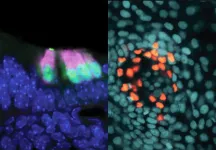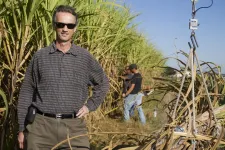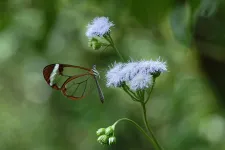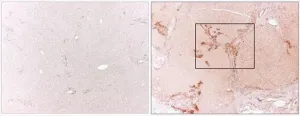A common ancestor for cells involved in hearing and touch
USC Stem Cell scientists point to developmental and evolutionary similarities between sensory cells in the inner ear and the skin
2021-07-12
(Press-News.org) The sensory cells in the inner ear and the touch receptors in the skin actually have a lot in common, according to a new study from the USC Stem Cell laboratory of Neil Segil published in the Proceedings of the National Academy of the Sciences (PNAS).
"There are striking similarities in the development of two types of specialized sensory cells: the so-called 'hair cells' that receive sound vibrations in the inner ear, and the Merkel cells that sense light touch at the surface of the skin," said Segil, who is a Professor in the Department of Stem Cell Biology and Regenerative Medicine, and the USC Tina and Rick Caruso Department of Otolaryngology - Head and Neck Surgery. "Ultimately, these developmental similarities are a legacy of shared evolutionary history. This demonstrates how the story of evolutionary developmental biology, or 'evo devo,' also extends to what we call the 'epigenetic level'--or how genes are regulated."
In the study, PhD student Haoze (Vincent) Yu, postdoctoral scholar Litao Tao, and their colleagues identified a shared mechanism involved in gene regulation or epigenetics, that enables stem cells and progenitor cells to differentiate into more specialized hair cells and Merkel cells.
In order to begin the process of differentiation, the right parts of a stem cell's DNA need to be taken out of storage. Each human cell can store around six feet of DNA in its nucleus, because this DNA is wound around tiny "spools" made up of proteins called histones. These spools of DNA and histone protein are further packed together to form what are known are nucleosomes, which are stacked to create chromatin, which is the material that makes up the chromosomes.
When DNA is wound tightly into this storage configuration, the chromatin is closed and inaccessible to the protein ATOH1. This protein is a "master regulator" that can activate a network of differentiation genes in the DNA within the chromatin--but not without first gaining access.
To this end, ATOH1 stimulates the production of a second protein known as POU4F3, an aptly named "pioneer factor" with the ability to venture into new frontiers by binding to closed and inaccessible chromatin. After POU4F3 blazes a trail by binding to the closed chromatin, ATOH1 is able to move forward with engaging and activating the network of genes that drives differentiation into hair cells and Merkel cells.
Strikingly, there is significant overlap in the specific regions of chromatin that POU4F3 makes accessible to ATOH1 in hair cells and Merkel cells.
"It's remarkable that these two cell types, which are both involved in sensing mechanical stimuli but derive from distinct parts of the embryo, both rely on the same ATOH1/POU4F3 mechanism in order to differentiate," said Segil. "Our study suggests that this mechanism is extremely ancient, and emerged before hair cells and Merkel cells diverged from a common evolutionary ancestor--an 'ur-mechanoreceptor' cell type."
INFORMATION:
Additional co-authors of the study include Juan Llamas, Xizi Wang, John D. Nguyen and Talon Trecek in the Segil Lab at USC.
Major support for this research came from the National Institute on Deafness and Other Communication Disorders (R01DC015829, R01DC015530, T32DC009975, F31DC017376, F31DC018703) and the Eunice Kennedy Shriver National Institute of Child Health and Human Development (T32HD060549). Additional support came from the Hearing Restoration Project of the Hearing Health Foundation.
[Attachments] See images for this press release:

ELSE PRESS RELEASES FROM THIS DATE:
2021-07-12
The Lucinidae family, lucinids for short, comprises approximately 500 living species of bivalves. They are at least 400 million years old, according to fossil records, and have managed to colonize a wide variety of habitats, from beautiful beaches to the abyssal depths untouched by the sun over a kilometer below the sea surface. Their ability to thrive in a wide variety of habitats is made possible by their 'partner in crime', a sulfur-oxidizing bacterial symbiont that utilizes hydrogen sulfide, better known as 'rotten egg gas', as an energy source to power primary production. This process is not unlike photosynthesis used by plants, yet not dependent on sunlight, ...
2021-07-12
BOSTON - By implementing a long-term, prospective approach to the development of celiac disease, a collaborative group of researchers has identified substantial microbial changes in the intestines of at-risk infants before disease onset. Using advanced genomic sequencing techniques, MassGeneral Hospital for Children (MGHfC) researchers, along with colleagues from institutions in Italy and the University of Maryland, College Park, uncovered distinct preclinical alterations in several species, pathways and metabolites in children who developed celiac disease compared to at-risk children who did not develop celiac disease.
As part of the MGHfC Celiac Disease, Genomic, Microbiome and Metabolomic (CDGEMM) Study, researchers ...
2021-07-12
Communities trying to fight sea-level rise could inadvertently make flooding worse for their neighbors, according to a new study from the END ...
2021-07-12
Better treatments of HER2-positive breast cancer are closer at hand, thanks to new research by a team led by Université de Montréal professor Jean-François Côté at the cytoskeleton organization and cell-migration research unit of the UdeM-affiliated Montreal Clinical Research Institute.
Published in PNAS, the journal of the U.S. National Academy of Sciences, the new research by Marie-Anne Goyette, a doctoral student in Côté's laboratory, reveals a highly promising therapeutic target to counter the HER2-positive breast cancer.
In HER2-positive breast cancer, a gene called HER2 is expressed that promotes an aggressive form of the disease. Affecting 20 per cent of ...
2021-07-12
ITHACA, N.Y. - Traces of the gas phosphine point to volcanic activity on Venus, according to new research from Cornell University.
Last autumn, scientists revealed that phosphine was found in trace amounts in the planet's upper atmosphere. That discovery promised the slim possibility that phosphine serves as a biological signature for the hot, toxic planet.
Now Cornell scientists say the chemical fingerprint support a different and important scientific find: a geological signature, showing evidence of explosive volcanoes on the mysterious planet.
"The phosphine is not telling us about the biology ...
2021-07-12
AUSTIN, Texas -- Lead exposure in childhood may lead to less mature and less healthy personalities in adulthood, according to a new study lead by psychology researchers at The University of Texas at Austin.
The study, published in the Proceedings of the National Academy of Sciences, sampled more than 1.5 million people in 269 U.S. counties and 37 European nations. Researchers found that those who grew up in areas with higher levels of atmospheric lead had less adaptive personalities in adulthood -- lower levels of conscientiousness and agreeableness and higher levels of neuroticism.
"Links between lead exposure and personality traits are quite impactful, because we take our personalities with us everywhere," ...
2021-07-12
Sugarcane is one of the most productive plants on Earth, providing 80 percent of the sugar and 30 percent of the bioethanol produced worldwide. Its size and efficient use of water and light give it tremendous potential for the production of renewable value-added bioproducts and biofuels.
But the highly complex sugarcane genome poses challenges for conventional breeding, requiring more than a decade of trials for the development of an improved cultivar.
Two recently published innovations by University of Florida researchers at the Department of Energy's Center for Advanced Bioenergy and Bioproducts Innovation (CABBI) demonstrated the ...
2021-07-12
Butterflies and moths have beautiful wings: the bright flare of an orange monarch, the vivid stripes of a swallowtail, the luminous green of a Luna moth. But some butterflies flutter on even more dramatic wings: parts of their wing, or sometimes the entire wing itself, are actually transparent.
Many aquatic organisms, including jellies and fish, are transparent. But transparent butterfly and moth wings are so arresting that merely catching a glimpse of one typically causes a human to lunge for a camera or at least point it out to their friends. These enigmatic, transparent butterfly wings have not been studied comprehensively.
Doris Gomez and Marianne Elias (French National Center for Scientific Research) set out to change that. Last week, along with a multidisciplinary ...
2021-07-12
Chronic alcohol abuse and hepatitis can injure the liver and lead to fibrosis, the buildup of collagen and scar tissue. As a potential approach to treating liver fibrosis, University of California San Diego School of Medicine researchers and their collaborators are looking for ways to stop liver cells from producing collagen.
"So we thought...what if we take immunotoxins and try to get them to kill collagen-producing cells in the liver," said team lead Tatiana Kisseleva, MD, PhD, associate professor of surgery at UC San Diego School of Medicine. "If these antibodies carrying toxic molecules can find and bind the cells, the cells will eat up the 'gift' and die."
In a study published July 12, 2021 in Proceedings of the National Academy of Sciences, Kisseleva ...
2021-07-12
Having a home near a busy airport certainly has its perks. It is close to many establishments and alleviates the problem of wading through endless traffic to catch flights. But it does come at a cost -- tolerating the jarring sounds of commercial airplanes during landing and takeoff.
Researchers at Texas A&M University have conducted a computational study that validates using a shape-memory alloy to reduce the unpleasant plane noise produced during landing. They noted that these materials could be inserted as passive, seamless fillers within airplane wings ...
LAST 30 PRESS RELEASES:
[Press-News.org] A common ancestor for cells involved in hearing and touch
USC Stem Cell scientists point to developmental and evolutionary similarities between sensory cells in the inner ear and the skin





